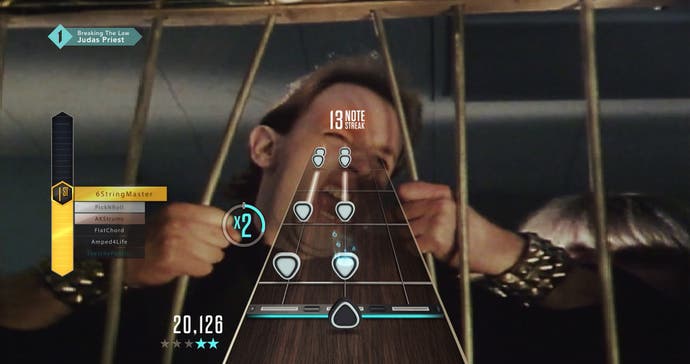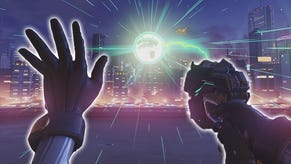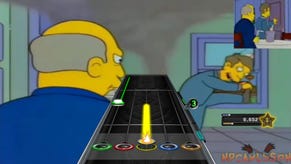Guitar Hero's decadent reboot breathes new life into the series
Fret not. First impressions ahead of our final review.
Editor's note: Guitar Hero Live, Activision and FreeStyle Games' reboot of the rhythm action series, releases this week. Seeing as a large part of Guitar Hero Live is built around the new online service, Guitar Hero TV, we're holding off on our review until we have adequate experience of the game on fully stressed servers, and we currently anticipate having our final impressions live by the end of the week. Before then, here are early impressions culled from a handful of days with Guitar Hero Live.
In Guitar Hero's previous life, die-hard fans could seek out different faceplates to modify their controller. In the early stages of getting one's head - and fingers - around the fret riddles of Guitar Hero Live, an L-plate might be more appropriate. Of all the game's attempts to put some clear blue water between its traditional, recently resurgent rival and the franchise's own burn-bright, fade-away history, rethinking the fundamentals of the controller seems even more audacious than the you-are-there live footage gimmick. It forces veteran Guitar Heroes to admit that yeah, maybe they were stuck in as much of a worn-out groove as the game, relying on sight-reading and muscle memory to cruise through each new batch of songs while simultaneously complaining about the lack of anything new.

Of course, it's not so much of a hard reboot that the plastic guitar itself has been abandoned. Compared to Rock Band 4's rather ritzy replica Fenders, the revamped Guitar Hero Live controller is less flashy but feels solid, with a noticeably longer strum bar that, unlike its silent rival, still responds with a satisfying click. The key changes are all at the other end; fitting for a game that is sticking its neck out. Optimising the traditional five fret buttons to two stacked rows of three means there's no longer any need to move your fret-wrangling hand, so pinkies made spry and limber from years of dutifully following orange lozenge prompts suddenly have nothing to do. But if Guitar Hero Live requires considerably less physical dexterity than before, the mental demands become surprisingly intense as soon as you nudge the difficulty level above regular.
The crisp, streamlined redesign of the familiar scrolling highway of fret prompts tricks you into thinking that rattling through a Lumineers track will be rather straightforward and jolly. But not since Ikaruga have streams of black and white blobs come freighted with such portent. In the early running, I was apparently incapable of remembering the simple fact that a black plectrum prompt meant "depress the top row button" and would hopelessly flail at the wrong input. It took a wily mindhack - repeatedly chanting "BLACK MEANS UP" loudly along with the backbeat of each song - for the new paradigm to, slowly, sink in.
What it does, though, is give long-standing players the chance to relive the sensation of mastering an instrument, which this particular veteran found unexpectedly satisfying. Being able to depress top and bottom fret buttons simultaneously also carries a flavour of strumming barred chords on a real guitar, which feeds into the rock idol fantasy, even if the process of interpreting a barrage of monochrome prompts into a face-melting turbo-riff seem slightly more abstract than intuitive: more math-rock than AC/DC. There's also no capacity for freestyle solos, which ended up being one of the innovations of Rock Band 4. But at this stage, Guitar Hero Live doesn't seem to suffer from the lack.

The naysayers - which would actually be a good name for a band - seemed ready to write off Guitar Hero Live after its launch trailer, which attempted to communicate the new live-footage-sourced gig experience by ladling on the first-person POV gimmicks: a roadie lowering a guitar strap over your head, winks from attractive fans, a haphazard spot of crowdsurfing. Uncharitably, you could say it looked like an ambitious episode of Peep Show set at Download festival. But Activision and FreeStyle Games have gone all in on their elaborate vision, and Guitar Hero Live's festival content - essentially a campaign mode where you help fictional bands deliver barnstorming sets - is technically impressive and executed with cinematic elan.
While your attention is still, for the most part, glued to the middle of the screen, whenever there's a break in the action - or you feel confident enough in your ability to let your eye wander - there are some pleasing Where's Wally-style moments to notice among the crammed mass of bodies, some unexpected lols that enhance the Lollapalooza vibe.
The crowd are fun, but the necessary proximity to your adopted on-screen bandmates could be more divisive. Depending on personal music taste, you might look around at the Arcade Fire-lite hipsters of Portland Cloud Orchestra and decide, then and there, to deliberately begin to start playing bum notes just to annoy the chubby guy gormlessly banging a bass drum. The moments where your performance slips so low that the cheering crowd transition into an angry mob are managed by a woozy optical effect, which is probably a fairly accurate representation of what would actually happen in your brain if you messed up a fairly straightforward Blink-182 guitar solo in front of 30,000 people.

There's sport in looking for the edits but for the most part, it's a genuinely dazzling display, a decadent use of resources that, tangentially, ties into the idea of being a flighty rock star. FreeStyle Games has created 42 of these elaborate mini-movies, and Guitar Hero Live is probably the first game that might pique the interest of grumpy auteur Brian De Palma, the master of the POV shot and byzantine unbroken takes, who would probably enjoy breaking down how each seamless performance was visualised and created.
So the cinematic campaign mode provides an initial sugar rush. But the real meat will be Guitar Hero TV, the MTV-inspired music channel service on which FreeStyle Games hope to build a lasting community. It's perhaps the element of Guitar Hero Live that's proved hardest to communicate effectively but, essentially, it's a cross between old-fashioned MTV and a video jukebox, allowing players to drop into a global simultaneous playlist to try and notch high scores, or spend in-game currency (or cold hard cash) to play their favourites.
Guitar Hero TV is where the two-player mode and mic support should come into their own, although even in the age of Spotify, convincing longstanding Guitar Hero players that it's better to spend some cash dipping into a cloud catalogue rather than building up their own library could prove challenging. At launch, there will be over 150 songs in the mix, with more due to be added every Friday along with special bundled setlists of premium content. The servers officially go live today, and there's a tangible sense that everything up to this point has just been a warm-up. Now it's time to perform.









